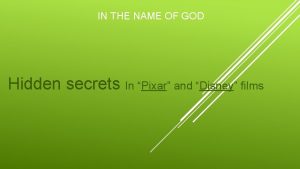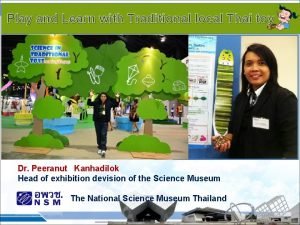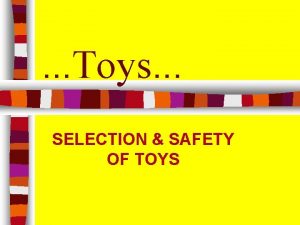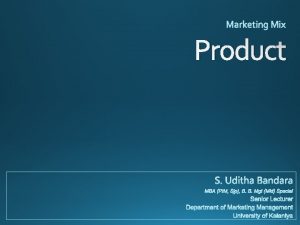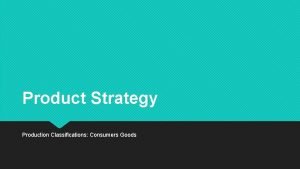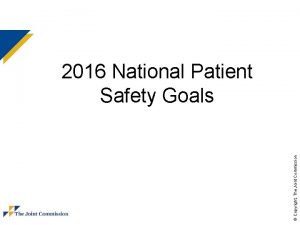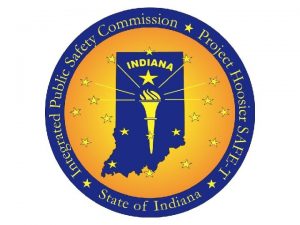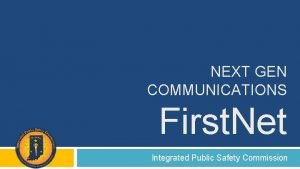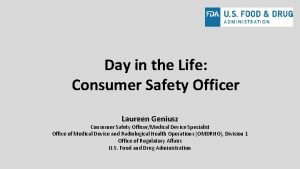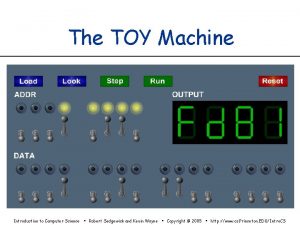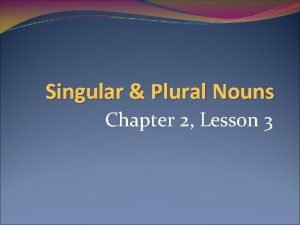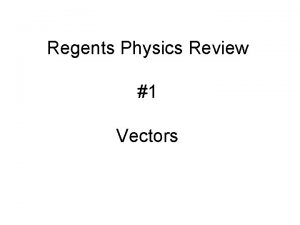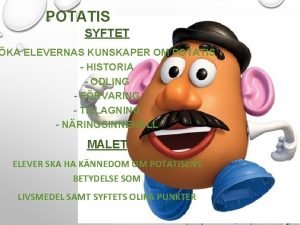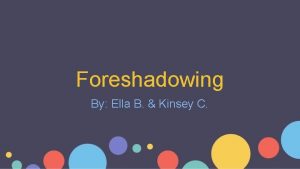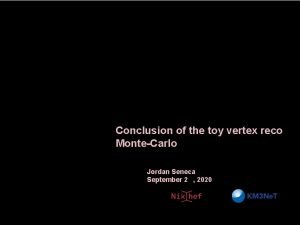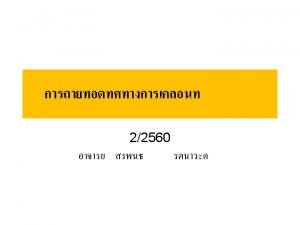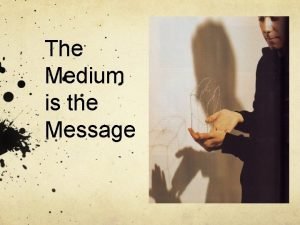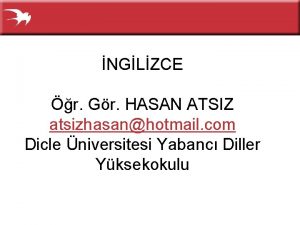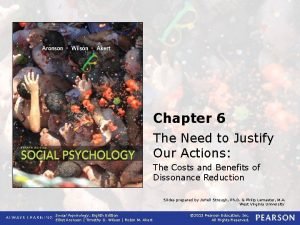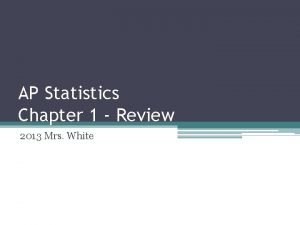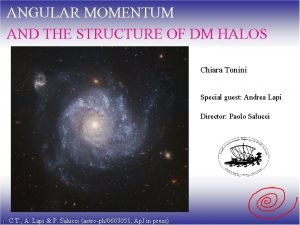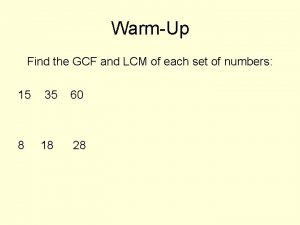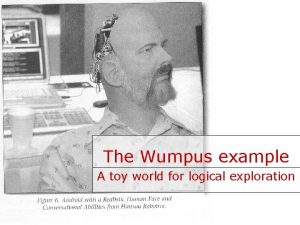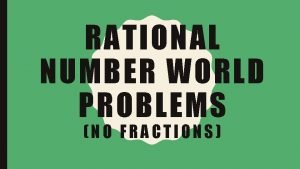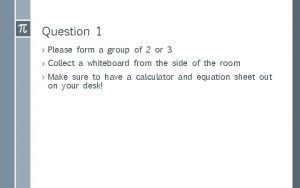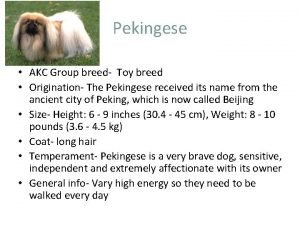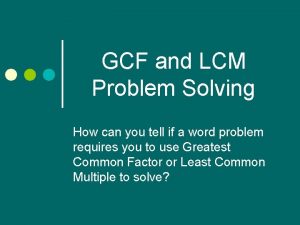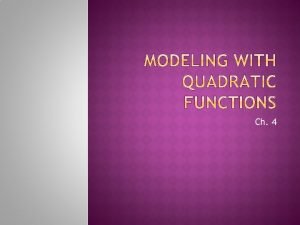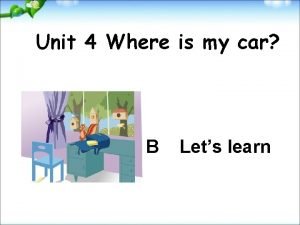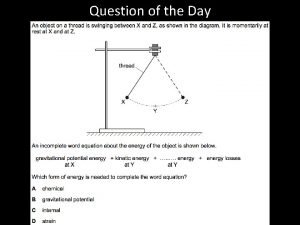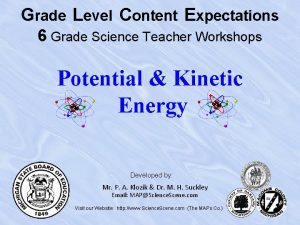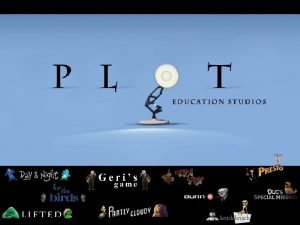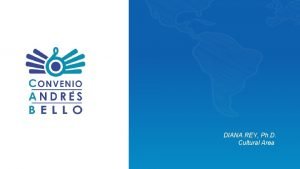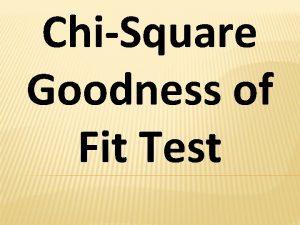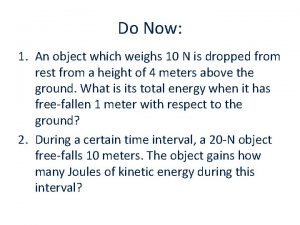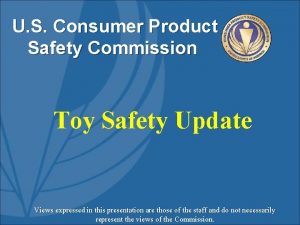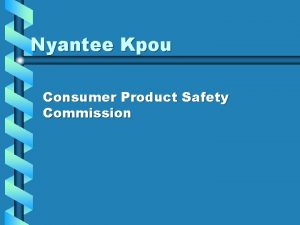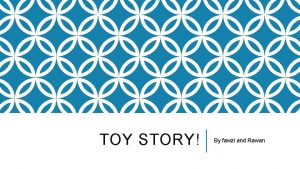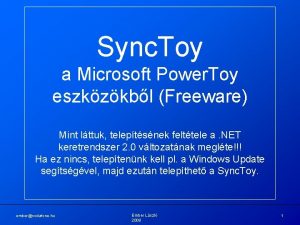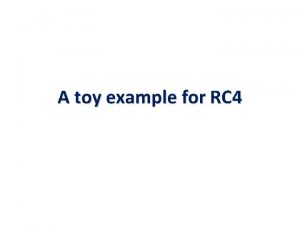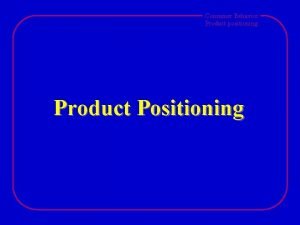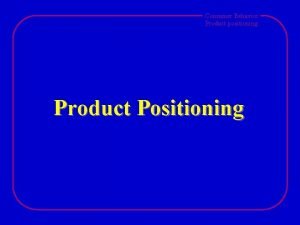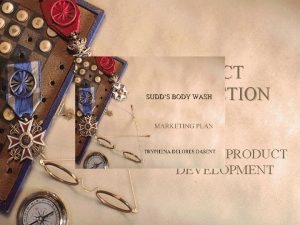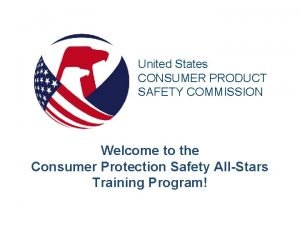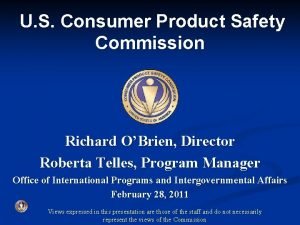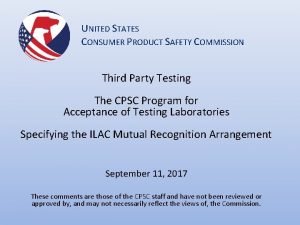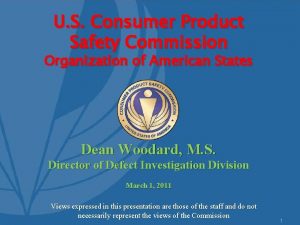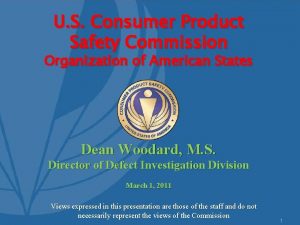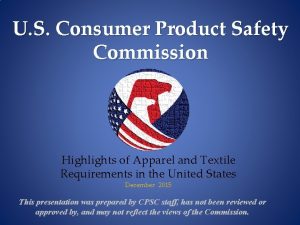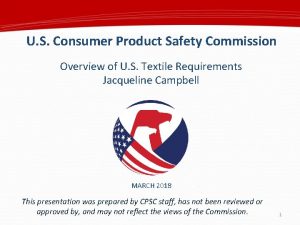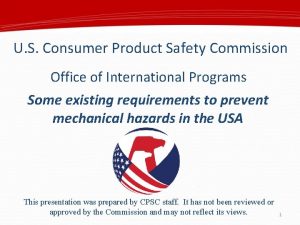U S Consumer Product Safety Commission Toy Safety




















































- Slides: 52

U. S. Consumer Product Safety Commission Toy Safety Update Views expressed in this presentation are those of the staff and do not necessarily represent the views of the Commission.

Today’s Agenda § Update on Consumer Product Safety Improvement Act (CPSIA) of 2008 and Public Law 112 -28 (August 12, 2011) § Toy Safety Standard & Other Children’s Product Safety Rules § CPSC Import Initiatives & Activities § CPSC Compliance Priorities n 2

Mission “Protecting the public against unreasonable risks of injury from consumer products through education, safety standards activities, regulation, and enforcement. ” n 3

Product Safety Standards n In general, CPSC statutes set a preference for voluntary private sector standards. n Private sector voluntary standards are often developed with the participation of CPSC staff. n 4

Consumer Product Safety Improvement Act (CPSIA) of 2008 n 5

Consumer Product Safety Improvement Act (CPSIA) of 2008 “Children’s products” designed or intended primarily for children 12 years old and younger n Key substantive requirements for children’s products : n Lead content in accessible components (100 ppm) n Lead in paint and surface coatings (90 ppm) n Phthalates (0. 1% per banned phthalate) – Toys and Child Care Articles (Sleeping & Feeding) Only n n 6

n Key process requirements for children’s products primarily intended for children 12 years old and younger: Third party testing by CPSC-accepted labs n Conformity certificates issued by importers & manufacturers (Children’s Product Certificate) n Tracking labels n n New safety rules for durable infant products: Cribs; infant walkers; bath seats; toddler beds; play yards; bed rails; additional items every six months n Product registration cards 7 n n

Overview of U. S. Toy Regulations www. cpsc. gov/toysafety n 8

Overview of U. S. Toy Regulations n Age grading of toys n Requirements for Toys under the Federal Hazardous Substances Act (FHSA) n Additional requirements under the Consumer Product Safety Improvement Act (CPSIA) n Mandatory Toy Standards ASTM F 963 -2008 with toy chest provision (previously voluntary)

Age Grading of Toys n Age grading: n n n matches the attributes of the toy to the capabilities of the child; and is used to determine the appropriate tests to which a product must comply. The Commission considers: n n the manufacturer’s labeling on the product, if it is reasonable; whether the product is advertised, promoted, and marketed for that age child; whether the product is recognized commonly by consumers as being intended for that age child; and Age Determination Guidelines – September 2002.

Key Federal Hazardous Substance Act (FHSA) Requirements n Small Parts Requirements* 16 C. F. R. Part 1501. n Sharp Points/ Edge Requirements 16 C. F. R. § § 1500. 48/49. n CSPA Labeling Requirements 16 C. F. R. § 1500. 19 and 16 C. F. R. § 1500. 121. n Art Material Requirements 16 C. F. R. § 1500. 14(b)(8). n Lead-in-Paint* 16 C. F. R. Part 1303. n Electrically Operated Toys/ Children’s Products** 16 C. F. R. Part 1505. *Third party testing required ** Third party testing required except for small batch manuf. (“Group B”) n 11

ASTM F 963 Not All Sections of F 963 Apply to Every Toy n Some Sections of F 963 Require Third Party Testing, Some Sections Do NOT require Third Party Testing n Some Sections of F 963 Are Covered by Existing CPSC Regulations in the CFR (Code of Federal Regulations 16 CFR Part 1000 to End) n n 12

Partial List of Requirements ASTM F 963 n n n n n Sound-Producing Toys Battery-Operated Toys Small Objects Stuffed and Beanbag-type Toys Projections Marbles and Balls Folding Mechanisms and Hinges Hemispheric-Shaped Objects Cords and Elastics in Toys Yo-Yo Elastic Tether Toys n n n n n Wheels, Tires, and Axles Magnets Pacifiers Balloons Projectile Toys Certain Toys with Spherical Ends Rattles Teethers and Teething Toys Squeeze Toys n 13

ASTM F 963 -08 Sections Testing Not Required Sections that address requirements for labeling, instructional literature, or producer’s markings; n Sections that involve assessments that are conducted by the unaided eye and without any sort of tool or device. n Sections that pertain to the manufacturing process and thus, cannot be evaluated meaningfully by a test of the finished product (e. g. , the purified water provision at section 4. 3. 6. 1); and n n 14

ASTM F 963 -08 Sections Notice of Requirements n Page 3 of the Notice of Requirements (“NOR”) sets forth the specific sections in ASTM F 963 -08 (and ASTM F 96307) that require third party testing. n Notables sections n Toy Chests ASTM F 963 -07 n Surface Coating Material – Soluble Test for Metals n Toy Testing Manual (2010 Version) n 15

ASTM F 963 -11 What's new? Heavy Metals-Limits for toy substrates n Compositing Procedure for Total Heavy Metal Analysis n Bath Toy Projections n Other revisions to include: jaw entrapment; toys with spherical ends; stability of ride on toys; requirements for squeeze toys attached to rings; use of cords, straps and elastics; packaging film; and yo-yo tether balls. n

When will I be required to comply with the new standard? • • • CPSC always has 90 days from notification to reject in whole or in part, the revised standard if it does not improve safety. Commission voted on February 15, 2012 to approve the revised standard (F 963 -11) and it became effective on June 12, 2012. Compliance with the revised standard is currently required. Third party testing at CPSC-accepted laboratory will be required soon for the new requirements. Otherwise, you must continue third party testing for compliance with the unchanged sections of F 963 -08.

Banned Phthalates Children’s Toys and Child Care Articles www. cpsc. gov/phthalates n 18

Permanent Ban on Phthalates Section 108 of the CPSIA n n n Congress has permanently banned three types of phthalates (DEHP, DBP, BBP) in any amount greater than 0. 1 percent (computed for each phthalate, individually) in (1) children's toys and (2) certain child care articles. A "children's toy" is defined as a consumer product designed or intended by the manufacturer for a child who is 12 years old or younger for use by the child when the child plays. "Child care articles" are defined as consumer products that are designed or intended by the manufacturer for a child who is 3 years old or younger, to facilitate sleeping or feeding, or to help a child who is sucking or teething. n 19

Interim Ban on Phthalates Section 108 of the CPSIA n n Congress has also banned (on an interim basis) three additional types of phthalates (DINP, DIDP, Dn. OP) in any amount greater than 0. 1 percent (computed for each phthalate individually) in (1) a children's toy that can be placed in a child's mouth, and (2) child care articles. A toy that can be placed in a child's mouth is defined as any part of a toy that actually can be brought to the child's mouth and kept there so that it can be sucked or chewed on. If a toy or a part of the toy is smaller than 5 centimeters, it can be placed in the mouth. n 20

Bans on Phthalates Section 108 of the CPSIA n n n The ban does not apply to component parts that are inaccessible to a child. Applies only to plasticized component parts (or other product parts which could conceivably contain phthalates) of children's toys and child care articles and only those parts of the product should be third party tested for phthalates. It is not necessary to test and certify materials that are known not to contain phthalates or to certify that phthalates are absent from materials that are known not to contain phthalates. n 21

Tracking Labels www. cpsc. gov/trackinglab el n 22

Tracking Labels Product and its packaging, if practicable n Commission policy document sets forth the substantive requirements, including: n n n the name of the manufacturer or private labeler; the location and date of production of the product; detailed information on the manufacturing process, such as a batch or run number, or other identifying characteristics; and any other information to facilitate ascertaining the specific source of the product. No mandated format. Each product type may be unique. n 23

Third Party Testing and Certification Requirements (Periodic Testing and Component Part Testing) www. cpsc. gov/3 PT n 24

What is third party testing? n n Third party testing is testing performed by an accredited laboratory that is owned by a third party (i. e. , not you) and is accepted by the CPSC to conduct testing on consumer products using approved test methods in accordance with established federal safety standards. There are three types of third party testing: n n n initial third party testing (also called certification testing); material change testing; and periodic testing. n 25

Identify a CPSC-Accepted Laboratory n All non-exempt materials must be third party tested by a CPSC-accepted laboratory, and manufacturers must issue a Children’s Product Certificate. n n n Alternative requirements for registered small batch manufacturers. www. cpsc. gov/smallbatch All CPSC-accepted laboratories are accredited, but not all accredited laboratories are CPSCaccepted laboratories. Laboratories are accepted by the CPSC on a test-by-test basis. To lower costs, you should try 26 n 26

Initial Testing & Certificate of Conformity www. cpsc. gov/labsearch n CPSC-accepted laboratory performs applicable testing and provides you with testing results. n You – the manufacturer or importer – are responsible for issuing a certificate of conformity based on passing results. (Children’s Product Certificate). n Laboratory may assist you, but you are the responsible party. n n 27

Material Change Testing & Certificate of Conformity If you – the manufacturer or importer – make a material change to the product after initial certification, you must: 1. Re-test the affected component part or the entire product; and 2. Issue a new Children’s Product Certificate n n www. cpsc. gov/3 PT (Resources section) n 28

Periodic Testing Rule Effective on February 8, 2013 n After initial testing and certification, periodic testing is required at a minimum of once per year, depending on your particular product. n You can possibly increase the amount of time to once every 2 years if you have a production testing plan in place or once every 3 years with continued testing using n n 29

Periodic Testing and Component Part Testing n Again, currently you must third party test and certify your products (and any material changes to your products) manufactured after December 31, 2011. n n You are not required to conduct periodic testing until February 8, 2013. You must retest and recertify if you’ve made a material change in the interim period. n 30

Component Part Testing You may rely upon a Component Part Certificate or component part test results from your supplier if the supplier meets all of the requirements that are in the rule at 16 CFR 1107 (i. e. , uses a CPSC-accepted laboratory, keeps records, and, eventually, conducts periodic testing. ) n You must “exercise due care” to rely upon the Component Part Certificate or component part test results. n n 31

Component Part Testing The concept of due care is flexible, and it will vary depending upon the circumstances and the industry in question. n A party “exercising due care” must use the degree of care that a prudent and competent person engaged in the same line of business or endeavor would exercise under similar circumstances. n n 32

Component Part Testing At a minimum, due care requires taking some affirmative step to ensure the validity of the test report or certification being relied upon. n Actions taken by a certifier to ensure the reliability of test reports from a supplier may differ depending on the nature of the component part supplied, the risk of noncompliance, the industry involved, and the nature of the relationship with the supplier. n n 33

Component Part Testing A long-term relationship with a trusted supplier that receives a large portion of its profits from one manufacturer may not require the same level of inquiry or monitoring as that of a new supplier that provides parts to many different manufacturers infrequently. n Depending on the industry and the facts, a certifier may take various actions in order to know something about the validity of the test reports or certifications being relied upon. n n 34

Component Part Testing n For example, depending on the industry and the circumstances, the exercise of due care may include: asking questions about testing and sampling procedures; n requesting written test procedures; n ensuring the supplier’s third party conformity assessment body is CPSC-accepted; n spot checking a supplier’s test results; or n visiting a supplier’s factory or third party laboratory. n n 35

SMALL BATCH MANUFACTURERS Public Law 112 -28 (August 12, 2011) www. cpsc. gov/smallbatch n 36

CPSC Import Initiatives

Import Safety Working Group Strategic Framework Shift paradigm from border-focused intervention to life-cycle approach n Emphasize prevention and risk-based approaches n Enlist the private sector n Ensure accountability through stronger enforcement n Promote cooperation among agencies and between nations n n 38

Office of Import Surveillance and Inspection Co-located Compliance Investigators at Major Ports n Cross-training technical staff; joint operations at ports /launching joint regulatory audits n International Trade Specialists at the Commercial Targeting and Analysis Center (CTAC) – Washington D. C. REAL TIME DATA n ITDS / Risk Assessment Methodology (RAM) Project n n 39

How will the CPSC use the ITDS / RAM? ITDS / RAM will allow CPSC staff at the ports to have more data and technology tools for business decision-making Processes Supported By Pilot 1. View detailed data on shipments in the past 24 hours (historical data will be maintained) 2. Evaluate risk scored entry line data to determine shipments targeted for inspection or determination of no action required 3. Conduct research and analysis on entry line data to make appropriate business decisions at the port 4. Manage port shipment data by using system provided status changes using “Actions” n 40

CPSC – Consumer Product Safety Improvement Act (CPSIA) Prohibited Acts (15 USC 2068) n Import any product not in conformity with rule, standard or ban n Import any product subject to a voluntary corrective action taken by manufacturer, Commission has notified the public and manufacturer knew or should have known n Fail to furnish certificate or present false certificate of conformity n Unauthorized use of a safety mark n Imported Products (15 USC 2066) n Product refused admission shall be destroyed unless … n Upon application by importer, Secretary of the Treasury permits the export in lieu of destruction n n 41

CPSC – Import Procedures n CPSC Sampling and Detentions n n n Specific statutory authority for sampling (15 USC 2066, 15 USC 1273) Detained merchandise remains under CBP custody CPSC Will Issue Notices of Detention n Compliance Investigator or Field Investigator will issue Notice will describe the suspected violation and the statute governing that suspected violation; CPSC officer contact information will be on the Notice issued to importer with copies to Customs broker and CBP n 42

CPSC – Import Procedures n Detentions – Time Frames n Detention notices to be issued as soon as possible after sampling/examination n Recipient of Notice has 5 business days to provide information to help resolve the detention; extensions can be granted n Policy is to try to resolve detentions within 30 days n Detentions of shipments under both CBP and CPSC authority n Detention notifications will be issued by both agencies n If CBP seizes that will resolve the CPSC detention but not final CPSC action (Letter of Advice could be issued) n If CBP resolves its detention in favor of the importer, it will not release the merchandise without resolution of the CPSC 43 detention n

CPSC – Import Procedures n Conditional Release of Merchandise n CPSC can allow conditional release of merchandise under CBP bond pending results of examination and testing n Merchandise cannot be distributed while under conditional release n Case-by-case consideration n Redelivery of Merchandise n Redelivery notice issued by CBP. Must be within 30 days after the end of the conditional release period n Redelivery could lead to seizure, destruction or exportation n 44

CPSC – Import Procedures n n Exportation/Destruction n Importer may ask to export or destroy at any time n Per agreement, exportation or destruction at importer’s expense and must occur under Government supervision Seizure n CPSC can request CBP to seize the product under Tariff Act authority n If seized, then CBP takes over the process n Fines, Penalties and Forfeitures Office issues notices; CBP has authority to remit the forfeiture upon terms and conditions deemed appropriate n CPSC can suggest disposition but cannot compel it 45 n

Import Samples Collected n 46 Last Update: 07/12/2012

Recalls by Source Country n 47

Regulated vs. Defective Product Recalls Last Update: 05/11/2012 48

Type of Toy (Hazard) 2008 2009 2010 TOTAL 25 15 17 Balloons (airway obstruction, aspiration, asphyxiation) 2 2 5 Tricycles (drowning, motor vehicle involvement) 4 4 Rubber balls/other small ball (airway obstruction, aspiration, choking, asphyxiation) 2 Nonmotorized riding toys/unspecified riding toys (fall, motor vehicle involvement, drowning) 4 1 Toy boxes (asphyxiation, entrapment, drowning) 1 1 2 Nonmotorized scooters (motor vehicle involvement) 2 1 1 Stuffed toys/doll accessory (suffocation, aspiration) 1 2 1 Balls, other (motor vehicle involvement, drowning) 2 Powered riding toys (drowning) 3 1 2 Other toys with a single reported fatality in the year (asphyxiation, drowning, gastroesophageal hemorrhage, toy pierced eye/brain) 7 2 4 In 2010, 65% of the reported deaths involved balloons, small balls, game, and accessory parts. Source http: //www. cpsc. gov/library/toymemo 10. pdf

Office of Compliance & Field Operations Enforcement of Third Party Testing, Certification, and Tracking Labels

Resources www. cpsc. gov/gettingstarted n www. cpsc. gov/toysafety n www. cpsc. gov/childrensproduct n www. cpsc. gov/labsearch n www. cpsc. gov/3 PT n www. cpsc. gov/lead n www. cpsc. gov/phthalates n Links, archived videos, and additional information available at: www. cpsc. gov/sbo n n 51

Presenter: Neal S. Cohen CPSC Small Business Ombudsman ncohen@cpsc. gov China Program Manager: Patte Bittner pbittner@cpsc. gov 301 -504 -7263 n 52
 Toy story 2 repairman
Toy story 2 repairman Toytoy thai
Toytoy thai Interpret a food chain or food web.
Interpret a food chain or food web. Child protection and toy safety act
Child protection and toy safety act Aims of secondary education commission 1952-53
Aims of secondary education commission 1952-53 Graduated commission definition math
Graduated commission definition math Is a greenfly a herbivore
Is a greenfly a herbivore Cengage
Cengage Consumer research in consumer behaviour
Consumer research in consumer behaviour Characteristics of consumer behavior
Characteristics of consumer behavior Types of buyer behavior
Types of buyer behavior Type of product example
Type of product example Consumer products classifications
Consumer products classifications Joint commission national patient safety goals 2016
Joint commission national patient safety goals 2016 Integrated public safety commission
Integrated public safety commission Integrated public safety commission
Integrated public safety commission Consumer safety officer
Consumer safety officer Toy program example
Toy program example Rawan plushie
Rawan plushie Panda plural form
Panda plural form Scalar is to vector as regents
Scalar is to vector as regents Minerva potatis
Minerva potatis Forbidden toy paradigma
Forbidden toy paradigma Stinky pete box template
Stinky pete box template What is the vertex of
What is the vertex of  Carl jung archetypes
Carl jung archetypes Four lobed cam
Four lobed cam Vik muniz self portrait
Vik muniz self portrait Brush plural nouns
Brush plural nouns Planet zeist toys
Planet zeist toys Is a toy car a conductor or insulator
Is a toy car a conductor or insulator Forbidden toy experiment
Forbidden toy experiment Vex windmill ideas
Vex windmill ideas Two parents have each built a toy catapult
Two parents have each built a toy catapult Quantum angular momentum toy
Quantum angular momentum toy Keywords for hcf and lcm
Keywords for hcf and lcm Wumpus toy
Wumpus toy A plastic toy submarine is held 15
A plastic toy submarine is held 15 A toy car with essentially frictionless
A toy car with essentially frictionless Akc pekingese
Akc pekingese Flow diagram of the energy system
Flow diagram of the energy system Sean has 8-inch pieces of toy train
Sean has 8-inch pieces of toy train Chapter 6 motion in two dimensions
Chapter 6 motion in two dimensions A model for the path of a toy rocket is given by
A model for the path of a toy rocket is given by The toy car rolled the chair
The toy car rolled the chair A car on a roller coaster track launched by a huge spring
A car on a roller coaster track launched by a huge spring Toy truck
Toy truck Geri's game rising action
Geri's game rising action Diana rey toy
Diana rey toy On one corner of my dresser sits a smiling toy clown
On one corner of my dresser sits a smiling toy clown Acme toy company prints baseball cards
Acme toy company prints baseball cards Function of descriptive essay
Function of descriptive essay A toy rocket that weighs 10 n
A toy rocket that weighs 10 n
